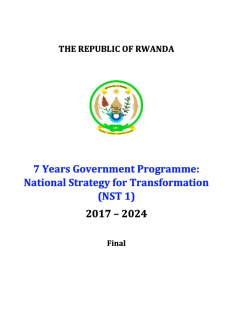The development landscape in Rwanda has changed considerably since the adoption of the Vision 2020 in the year 2000. The progress made in less than two decades has given Rwandans much hope and belief to aspire for greater achievements. The National Strategy for Transformation (NST1) which is also the Seven Year Government Programme (7YGP) comes at a unique moment in the country’s development trajectory which will see the crossover from Vision 2020 towards Vision 2050. This strategy is expected to lay the foundations for decades of sustained growth and transformation that will accelerate the move towards achieving high standards of living for all Rwandans.
The NST 1 will pick up from where the Economic Development and Poverty Reduction Strategy (EDPRS 2) left off, and continues in an effort to accelerate the transformation and economic growth with the private sector at the helm. NST1 will provide the foundation and vehicle towards Vision 2050, which aspires to take Rwanda to high living standards by the middle of the 21st century and high quality livelihoods. Specific priorities and strategies are presented under three pillars:
- Economic Transformation
- Social Transformation
- Transformational Governance
The strategy will also prioritize the following cross-cutting areas: Capacity Development, HIV/AIDS and Non-Communicable Diseases, Disability and Social Inclusion, Environment and Climate Change, Regional Integration and International Positioning, Gender and Family Promotion, Disaster Management.

